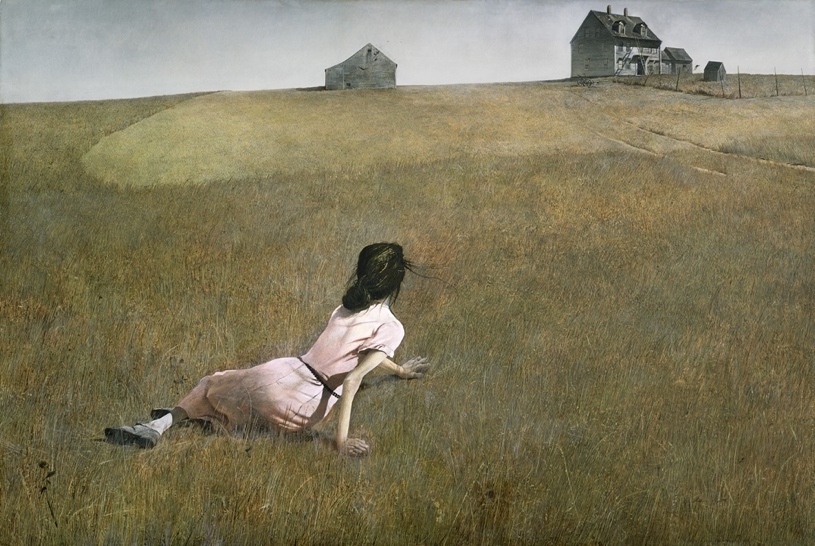Andrew Wyeth’s 1948 painting Christina’s World shows a young woman seen from her back, wearing a light pink dress, half-lying or half-sitting in a grass field, seemingly looking at the farmhouse in the distance. The young woman, despite being lower to the ground, has an alert or even intense silhouette, giving the impression that there is something specific on which she is focused, maybe looking for some help. The painting is not a still life portrait; rather, it combines genre and landscape styles as both the young woman and the nature around her play significant parts in the composition.

Christina’s World is two feet eight inches tall by four feet wide (32 1/4 x 47 3/4″). Painted with tempera on panel, the painting is currently on view at The Museum of Modern Art (MoMA) in New York at the Alfred H. Barr, Jr. Galleries. Completed in the realist style, the painting shows immense attention to detail, with every blade of grass in the field and every hair on the young woman’s head being attended to. Andrew Wyeth was born in 1917 and died in 2009, so Christina’s World, which was painted in 1948, could be considered an early to mid-career piece. It was painted in Cushing, Maine, as evidenced by the house illustrated, which is known as the Olson House and is today a National Historic Landmark. The Olson House was near Wyeth’s summer house, which means that the painter most likely completed the work in Maine (MoMA). It is more likely that personal use was the intended function of the painting because it was inspired by the artist’s neighbor, Christina Olsen.
Although depicting a scene in daylight, the painting has a certain darkness to it, which is hinted at by the muted colors reflecting the austerity of the landscape of New England. There is not much variety as the dominant texture is the grassy field, which takes up the majority of the painting, which means that the composition is simple and spacious. The main contrast is between Christina’s light pink dress and the khaki green grass, suggesting that the girl is the only bright mark in the painting. Asymmetrical balance applies to the painting as Christina is placed slightly to the left; however, her silhouette is balanced to the top right by the farmhouse in the distance, which creates harmony.
Christina herself is the first thing that one notices when looking at the painting. Upon further look, one discovers houses in the distance, which are painted in similar tones as the sky, although they stand out. The two focal areas, the girl and the houses, are being united with the expansive muted green field, allowing one to feel the distance as well as the overall emptiness of the landscape. The girl is painted with a lot of detail, so there is a lot to explore about her. For example, her pose itself may seem relaxed on the first look and then read as tense and alert upon further exploration. Even though the farmhouses are in the distance, one can distinguish each window, a wooden ladder rising from the ground to the roof, and a wooden plow left nearby.
The painting’s imagery and composition were inspired by Anna Christina Olson, who was a regular young woman. As a child, she had developed a degenerative muscle condition that left her unable to walk. Christina refused to use a wheelchair and preferred crawling, using the strength of her arms to move her body along (Hays). Therefore, the young woman in the picture is not lying on the ground for a rest, instead, she is shown in the process of getting to her home. The landscape around Christina also plays an integral part in the composition as it is shown as calm but not bright and happy. There is an intimate connection between the main subject of the painting and the nature around her – they exist in unison in a quiet but complex relationship.
Wyeth is known for seeing nature around him and including it in his studies of people. Therefore, Christina’s World is more a psychological landscape than an actual portrait of a young woman, portraying not a place but rather a person’s state of mind. According to the artist himself, “my people, my objects breathe in a different way […] when you really begin to peer into something, a simple object, and realize the profound meaning of that thing – if you have an emotion about it, there’s no end” (qtd. in “How Andrew Wyeth Made a Painting”).
Even though, at first glance, the main focus of the painting is placed on Christina and the beauty of New England nature around her. However, for an individual viewer getting to know the backstory behind the protagonist and the location of the setting, it becomes clear that the painter comments on the psychological strength of the young woman and her view of the world.
Works Cited
Hays, Patti. “From The CEO: Christina’s World.” AWS Foundation, 2020. Web.
“How Andrew Wyeth Made a Painting.” Open Culture. 2019. Web.
MoMA. “Andrew Wyeth: Christina’s World.”. Web.